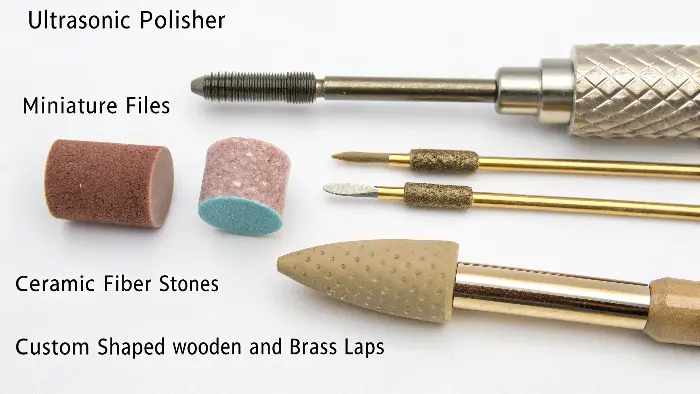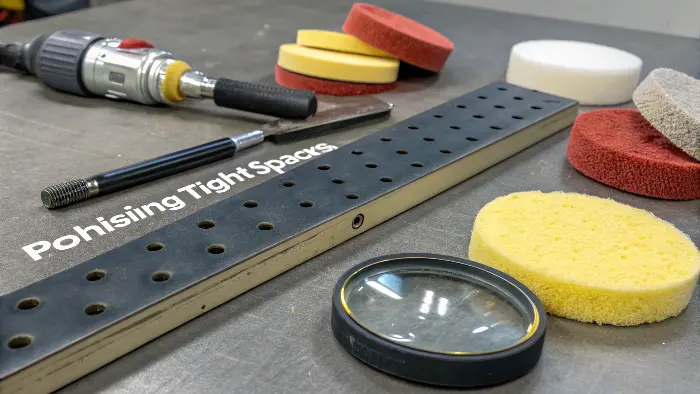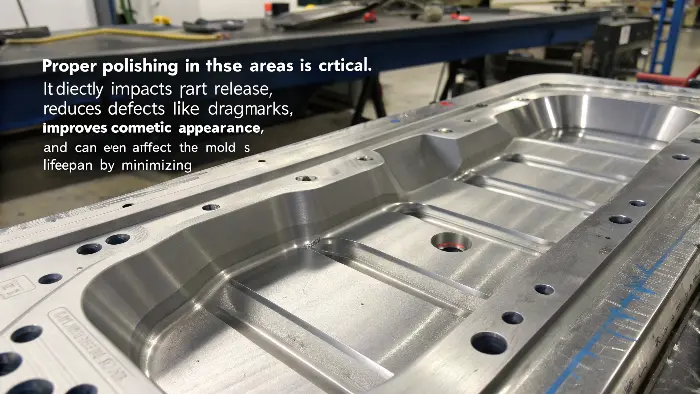Struggling with those tiny, deep features in your molds? It’s a common headache. We want perfect parts, but these spots make it tough.
The key to polishing deep ribs and narrow slots is using specialized, often miniaturized, tools and techniques that allow for precise material removal and surface finishing in highly constrained areas, ensuring dimensional accuracy and optimal part release.
Getting a mirror finish on a big, flat surface is one thing. But when you dive into the nitty-gritty of complex molds, those deep ribs and narrow slots? That’s where the real challenge – and skill – comes in. I’ve seen so many projects where these little areas can make or break the final product quality. So, let’s talk about how we tackle these demanding features. It’s something we’ve spent years perfecting, and I think sharing some insights might just help you out on your next tough project.
Why Is Polishing Deep Ribs and Narrow Slots Such a Headache?
Ever felt like you’re trying to paint a masterpiece through a keyhole? That’s what polishing deep ribs and narrow slots can feel like sometimes, a real test of patience.
The primary challenge is accessibility. These features are inherently difficult to reach, see, and work on with conventional tools, leading to inconsistent finishes and potential damage.
Let me tell you, when we talk about polishing deep ribs and narrow slots, it’s not just a walk in the park. I’ve seen plenty of projects where these features become the biggest bottleneck. The geometry itself is the main enemy here. Think about it – you’ve got these long, thin channels or tiny crevices. Standard polishing tools? They just won’t fit, or if they do, you can’t apply even pressure or control the movement effectively. This often leads to an uneven finish, with some spots over-polished (potentially rounding sharp edges that need to be, well, sharp!) and others barely touched, which can cause issues with part ejection or cosmetic flaws.
Another big problem is visibility. You’re often working almost blind, relying more on feel and experience than direct sight. This makes it super easy to miss spots or, even worse, accidentally alter the critical dimensions of the rib or slot. We’re talking about tolerances that can be incredibly tight, especially in molds for precision parts like those in consumer electronics or medical devices. And let’s not forget about debris removal. Polishing, by nature, creates tiny particles of abrasive and metal. In these confined spaces, they get trapped and can act like rogue abrasives, scratching the very surface you’re trying to perfect. It’s a bit like trying to clean a very thin flute with a regular bottle brush – frustrating and often ineffective! Honestly, it takes a special kind of patience, a steady hand, and a deep understanding of material behavior, not to mention the right approach, to get these areas just right. It’s something we’ve learned a lot about over the years here at CavityMold, often through trial and, thankfully, a lot of successful error correction.
What Special Tools Can Make Polishing These Awkward Features Easier?
| Are your standard polishing stones and papers just not cutting it for those tight spots? You’re probably wondering if there’s a secret weapon out there. Yes, specialized tools like ultrasonic polishers, miniature files, ceramic fiber stones, and custom-shaped wooden or brass laps are essential for effectively reaching and finishing deep ribs and narrow slots.  When you’re faced with those incredibly tight geometries, your regular toolkit just won’t do. I remember early in my career, trying to make do with what I had – it was a recipe for frustration and, frankly, suboptimal results. So, what do we use now? Well, the game really changed with ultrasonic polishing systems. These are fantastic. They use high-frequency vibrations to drive very small ceramic fiber stones, diamond files, or even wooden laps. This allows for incredibly precise material removal in tiny areas, even at the bottom of a deep, narrow slot. The stroke length and power can be controlled, which is crucial for delicate work. Then you have ceramic fiber stones, also known as "super stones." These are made of ceramic fibers in a resin binder and can be shaped to incredibly fine points or thin profiles. They maintain their shape well and can cut hardened tool steels effectively. We often dress them to match the exact profile of the rib or slot we’re working on. For really narrow slots, sometimes you need even finer tools. Miniature diamond files or rifflers with very specific shapes can be lifesavers. And don’t underestimate the power of good old wooden or brass laps charged with diamond paste. We often make custom laps – shaping a piece of wood or soft metal to fit perfectly into a feature. The key is that the lap material is softer than the mold steel, so it’s the diamond paste doing the cutting, not the lap itself. This prevents accidental damage to the mold. We also use flexible shaft grinders with miniature abrasive points or brushes, but these require a very delicate touch. It’s all about having an arsenal of tools because, honestly, no single tool is perfect for every situation. Here’s a quick look at some common choices: |
Tool Type | Primary Use in Deep Ribs/Slots | Key Advantage | Consideration |
|---|---|---|---|---|
| Ultrasonic Polisher | Precise material removal with fine tips/stones | Reaches very tight areas, controlled action | Can be slow, requires skill | |
| Ceramic Fiber Stones | Shaping, smoothing, pre-polishing | Can be dressed to fine points, good cutting | Brittle, can break if mishandled | |
| Miniature Files | Initial shaping, removing machine marks | Specific profiles for intricate shapes | Can remove too much material if not careful | |
| Custom Laps (Wood/Brass) | Final polishing with diamond paste | Conforms to feature, gentle polishing | Requires making custom shapes, paste selection | |
| Flexible Shaft Tools | Deburring, light polishing with small attachments | Versatile with different heads | Requires very steady hand, risk of over-polishing |
It’s all about having the right tool for the job, and sometimes, that means getting creative!
What Are the Go-To Techniques for Polishing in Those Tight Spaces?
Got the special tools, but still not getting that perfect sheen in those pesky narrow slots? It’s not just the tools, but how you use them.
Effective techniques involve directional polishing, gradual grit progression, maintaining consistent pressure, and frequent inspection to ensure uniformity and prevent over-polishing or dimensional changes.

Alright, so you’ve got your fancy ultrasonic polisher or your perfectly shaped ceramic stone. Now what? Well, the technique is just as critical as the tool, maybe even more so. One of the first things I always stress to our team is directional polishing. Whenever possible, you want to polish in the direction of part ejection. This creates microscopic lines that actually help the plastic part release from the mold. If you polish across the direction of draw, you can create undercuts or resistance. In a deep rib or narrow slot, this usually means polishing along its length. It’s painstaking, but it pays off.
Then there’s the gradual progression of grits. You can’t just jump from a coarse stone to a diamond paste and expect miracles. We start with a grit that’s coarse enough to remove the machining marks (like from EDM or milling) but not so coarse that it creates deep scratches of its own. Then, we meticulously work our way down through finer and finer grits. Each subsequent grit should remove the scratches from the previous one. This is super important – if you skip a grit, you’ll be fighting those deeper scratches forever. And in tight spaces, it’s easy to lose track. We also emphasize maintaining consistent, light pressure. Too much pressure, especially with power tools, can quickly remove too much material, altering dimensions or rounding off sharp corners that need to be, well, sharp. It’s better to take a bit more time with lighter pressure.
Frequent cleaning and inspection are also paramount. As I mentioned, debris can be a killer. So, we regularly flush out the area with a solvent and inspect it under magnification. This helps us see if we’re getting a uniform finish and if there are any problem spots. Sometimes, we even use dental mirrors or small borescopes to see into really inaccessible areas. And let’s be honest, sometimes you have to get creative. For extremely narrow slots, we might use fine wires or shims wrapped with very fine abrasive paper or charged with diamond compound. It’s all about adapting your approach to the specific geometry. Patience is key here; rushing this stage is a recipe for disaster. I’ve seen molds damaged beyond repair because someone got impatient trying to polish a tiny feature.
How Crucial is Proper Polishing in Deep Ribs for Mold Performance and Part Quality?
Thinking all this effort for tiny, often hidden, mold features is overkill? Why does polishing deep ribs and narrow slots really matter so much?
Proper polishing in these areas is critical. It directly impacts part release, reduces defects like drag marks, improves cosmetic appearance, and can even affect the mold’s lifespan by minimizing wear.

So, why do we go to all this trouble for what might seem like minor details in a mold? Well, let me tell you, the finish in those deep ribs and narrow slots can have a surprisingly big impact on both the injection molding process and the final part quality. First and foremost is part ejection. If these features are rough or have microscopic undercuts from improper polishing, the plastic part will stick. This can lead to drag marks on the part, distortion, or even parts getting stuck in the mold, causing production stoppages. I remember a case with a client where parts were consistently showing subtle scuff marks along some thin reinforcing ribs. The issue? The EDM finish in those ribs hadn’t been adequately polished out. A little extra care there solved a major headache for their production line.
Beyond just getting the part out, the finish affects the cosmetic appearance of the part. Even if a rib is internal, if it’s part of a transparent or translucent component, any imperfections in the mold surface will be visible. For high-end consumer products, this is a deal-breaker. Proper polishing ensures a clean, smooth surface on the molded part, reflecting the quality of the design. Furthermore, a well-polished surface is less prone to wear and corrosion. While tool steel is tough, a rougher surface has more peaks and valleys, offering more sites for corrosion to start or for wear to concentrate, especially if there’s any abrasive component in the plastic resin. Smooth surfaces last longer. Lastly, in some cases, especially with thin-walled ribs, a poor surface finish can even create stress concentration points in the molded part, potentially leading to premature failure. So, yes, it’s absolutely crucial. It’s one of those things that often goes unnoticed when done right, but causes big problems when done wrong. It’s a core part of what we mean at CavityMold by "Master Molding Right."
Conclusion
Mastering deep rib and slot polishing needs special tools, careful techniques, and patience. It’s vital for part quality and smooth production.
